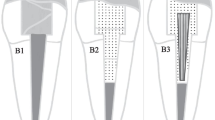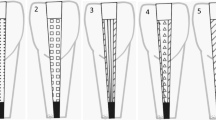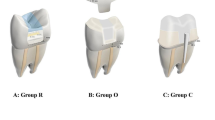Abstract
Objective
The aim was to investigate the fatigue performance of root canal-treated (RCT) molars restored with different direct restorations utilizing discontinuous and continuous fiber-reinforced composite (FRC) systems. The impact of direct cuspal coverage was also evaluated.
Materials and methods
One hundred and twenty intact third molars extracted for periodontal or orthodontic reasons were randomly divided into six groups (n=20). Standardized MOD, regular cavities for direct restorations were prepared in all specimens, and subsequently, root canal treatment and root canal obturation was carried out. After the endodontic treatment, the cavities were restored with different fiber-reinforced direct restorations as follows: SFC group (control), discontinuous short fiber-reinforced composite (SFC) without cuspal coverage (CC); SFC+CC group, SFC with cuspal coverage; PFRC group, transcoronal fixation with continuous polyethylene fibers without CC; PFRC+CC group, transcoronal fixation with continuous polyethylene fibers with CC; GFRC group, continuous glass FRC post without CC; and GFRC+CC, continuous glass FRC post with CC. All specimens underwent a fatigue survival test in a cyclic loading machine until fracture occurred or 40,000 cycles were completed. The Kaplan-Meier survival analysis was conducted, followed by pairwise log-rank post hoc comparisons between the individual groups (Mantel-Cox).
Results
The PFRC+CC group was characterized by significantly higher survival compared to all the groups (p < 0.05), except for the control group (p = 0.317). In contrast, the GFRC group showed significantly lower survival compared to all the groups (p < 0.05), except for the SFC+CC group (p = 0.118). The control group (SFC) showed statistically higher survival than the SFRC+CC group (p < 0.05) and GFRC group (p < 0.05), but it did not differ significantly from the rest of the groups in terms of survival.
Conclusions
Direct restorations utilizing continuous FRC systems (in the form of polyethylene fibers or FRC post) to restore RCT molar MOD cavities performed better in terms of fatigue resistance when CC was performed compared to the same FRC restorations without CC. On the contrary, teeth restored with SFC restorations performed better without CC compared to the ones where SFC was covered.
Clinical relevance
In the case of fiber-reinforced direct restorations for MOD cavities in RCT molars, direct CC is recommended when utilizing long continuous fibers for reinforcement, however, should be avoided when only SFC is used for their reinforcement.



Similar content being viewed by others
Data Availability
Data is contained within the article.
References
Al-Omiri MK, Mahmoud AA, Rayyan MR, Abu-Hammad O (2010) Fracture resistance of teeth restored with post-retained restorations: an overview. J Endod 36:1439–1449. https://doi.org/10.1016/j.joen.2010.06.005
Barcellos RR, Correia DP, Farina AP, Mesquita MF, Ferraz CC, Cecchin D (2013) Fracture resistance of endodontically treated teeth restored with intra-radicular post: the effects of post system and dentine thickness. J Biomech 46:2572–2577. https://doi.org/10.1016/j.jbiomech.2013.08.016
Dietschi D, Duc O, Krejci I, Sadan A (2007) Biomechanical considerations for the restoration of endodontically treated teeth: a systematic review of the literature--Part 1. Composition and micro- and macrostructure alterations. Quintessence Int 38:733–743
Tay FR, Pashley DH (2007) Monoblocks in root canals: a hypothetical or a tangible goal. J Endod 33:391–398. https://doi.org/10.1016/j.joen.2006.10.009
El-Helali R, Dowling AH, McGinley EL, Duncan HF, Fleming GJ (2013) Influence of resin-based composite restoration technique and endodontic access on cuspal deflection and cervical microleakage scores. J Dent 41:216–222. https://doi.org/10.1016/j.jdent.2012.11.002
Reeh ES, Douglas WH (1989) Messer HH Stiffness of endodontically-treated teeth related to restoration technique. J Dent Res 68:1540–1544. https://doi.org/10.1177/00220345890680111401
Seo DG, Yi YA, Shin SJ, Park JW (2012) Analysis of factors associated with cracked teeth. J Endod 38:288–292. https://doi.org/10.1016/j.joen.2011.11.017
Hood JA (1991) Biomechanics of the intact, prepared and restored tooth: some clinical implications. Int Dent 41:25–32
Taha NA, Palamara JE, Messer HH (2009) Cuspal deflection, strain and microleakage of endodontically treated premolar teeth restored with direct resin composites. J Dent 37:724–730. https://doi.org/10.1016/j.jdent.2009.05.027
Habekost LD, Camacho GB, Azevedo EC, Demarco FF (2007) Fracture resistance of thermal cycled and endodontically treated premolars with adhesive restorations. J Prosthet Dent 98:186–192. https://doi.org/10.1016/s0022-3913(07)60054-7
Fráter M, Forster A, Keresztúri M, Braunitzer G, Nagy K (2014) In vitro fracture resistance of molar teeth restored with a short fibre-reinforced composite material. J Dent 42:1143–1150. https://doi.org/10.1016/j.jdent.2014.05.004
Rocca GT, Krejci I (2013) Crown and post-free adhesive restorations for endodontically treated posterior teeth: from direct composite to endocrowns. Eur J Esthet Dent 8:156–179
Scotti N, Eruli C, Comba A, Paolino DS, Alovisi M, Pasqualini D, Berutti E (2015) Longevity of class 2 direct restorations in root-filled teeth: a retrospective clinical study. J Dent 43:499–505. https://doi.org/10.1016/j.jdent.2015.02.006
Fráter M, Sáry T, Jókai B, Braunitzer G, Säilynoja E, Vallittu PK, Lassila L, Garoushi S (2021) Fatigue behavior of endodontically treated premolars restored with different fiber-reinforced designs. Dent Mater 37:391–402. https://doi.org/10.1016/j.dental.2020.11.026
Fráter M, Sáry T, Molnár J, Braunitzer G, Lassila L, Vallittu PK, Garoushi S (2022) Fatigue performance of endodontically treated premolars restored with direct and indirect cuspal coverage restorations utilizing fiber-reinforced cores. Clin Oral Investig 26:3501–3513. https://doi.org/10.1007/s00784-021-04319-3
Garoushi S, Gargoum A, Vallittu PK, Lassila L (2018) Short fiber-reinforced composite restorations: a review of the current literature. J Investig Clin Dent 9:e12330. https://doi.org/10.1111/jicd.12330
Sáry T, Garoushi S, Braunitzer G, Alleman D, Volom A, Fráter M (2019) Fracture behaviour of MOD restorations reinforced by various fibre-reinforced techniques - an in vitro study. J Mech Behav Biomed Mater 98:348–356. https://doi.org/10.1016/j.jmbbm.2019.103505
Garoushi S, Sungur S, Boz Y, Ozkan P, Vallittu PK, Uctasli S, Lassila L (2021) Influence of short-fiber composite base on fracture behavior of direct and indirect restorations. Clin Oral Investig 25:4543–4552. https://doi.org/10.1007/s00784-020-03768-6
Jakab A, Volom A, Sáry T, Vincze-Bandi E, Braunitzer G, Alleman D, Garoushi S, Fráter M (2022) Mechanical performance of direct restorative techniques utilizing long fibers for "horizontal splinting" to reinforce deep MOD cavities-an updated literature review. Polymers (Basel) 14:1438. https://doi.org/10.3390/polym14071438
Kim SG, Kim SS, Levine JL, Piracha YS, Solomon CS (2020) A novel approach to fracture resistance using horizontal posts after endodontic therapy: a case report and review of Literature. J Endod 46:545–550. https://doi.org/10.1016/j.joen.2019.12.012
Bromberg CR, Alves CB, Stona D, Spohr AM, Rodrigues-Junior SA, Melara R, Burnett LH Jr (2016) Fracture resistance of endodontically treated molars restored with horizontal fiberglass posts or indirect techniques. J Am Dent Assoc 147:952–958. https://doi.org/10.1016/j.adaj.2016.08.001
Belli S, Cobankara FK, Eraslan O, Eskitascioglu G, Karbhari V (2006) The effect of fiber insertion on fracture resistance of endodontically treated molars with MOD cavity and reattached fractured lingual cusps. J Biomed Mater Res B Appl Biomater 79:35–41. https://doi.org/10.1002/jbm.b.30508
Néma V, Sáry T, Szántó LF, Braunitzer G, Fráter M (2022) Polymerization shrinkage-stress of short fiber-reinforced composite - pilot study. Fogorvosi Szemle 115:178–182. https://doi.org/10.33891/FSZ.114.4.178-182
Salameh Z, Sorrentino R, Papacchini F, Ounsi HF, Tashkandi E, Goracci C, Ferrari M (2006) Fracture resistance and failure patterns of endodontically treated mandibular molars restored using resin composite with or without translucent glass fiber posts. J Endod 32:752–755. https://doi.org/10.1016/j.joen.2006.02.002
Suksaphar W, Banomyong D, Jirathanyanatt T, Ngoenwiwatkul Y (2018) Survival rates from fracture of endodontically treated premolars restored with full-coverage crowns or direct resin composite restorations: a retrospective study. J Endod 44:233–238. https://doi.org/10.1016/j.joen.2017.09.013
Daher R, Feilzer AJ, Krejci I (2016) Novel non-invasive reinforcement of MOD cavities on endodontically treated teeth. J Dent 54:77–85. https://doi.org/10.1016/j.jdent.2016.09.008
Forster A, Braunitzer G, Tóth M, Szabó BP, Fráter M (2019) In vitro fracture resistance of adhesively restored molar teeth with different MOD cavity dimensions. J Prosthodont 28:e325–e331. https://doi.org/10.1111/jopr.12777
Szabó B, Garoushi S, Braunitzer G, Szabó PB, Baráth Z, Fráter M (2019) Fracture behavior of root-amputated teeth at different amount of periodontal support - a preliminary in vitro study. BMC Oral Health 19:261. https://doi.org/10.1186/s12903-019-0958-3
Soares LM, Razaghy M, Magne P (2018) Optimization of large MOD restorations: composite resin inlays vs. short fiber-reinforced direct restorations. Dent Mater 34:587–597. https://doi.org/10.1016/j.dental.2018.01.004
Scotti N, Coero Borga FA, Alovisi M, Rota R, Pasqualini D, Berutti E (2012) Is fracture resistance of endodontically treated mandibular molars restored with indirect onlay composite restorations influenced by fibre post insertion? J Dent 40:814–820. https://doi.org/10.1016/j.jdent.2012.06.005
Josic U, Radovic I, Juloski J, Beloica M, Popovic M, Alil A, Mandic J (2020) Can fiber-post placement reinforce structurally compromised roots? J Adhes Dent 22:409–414. https://doi.org/10.3290/j.jad.a44872
Karzoun W, Abdulkarim A, Samran A, Kern M (2015) Fracture strength of endodontically treated maxillary premolars supported by a horizontal glass fiber post: an in vitro study. J Endod 41:907–912. https://doi.org/10.1016/j.joen.2015.01.022
Chieruzzi M, Pagano S, Pennacchi M, Lombardo G, D'Errico P, Kenny JM (2012) Compressive and flexural behaviour of fibre reinforced endodontic posts. J Dent 40:968–978. https://doi.org/10.1016/j.jdent.2012.08.003
Bell AM, Lassila LV, Kangasniemi I, Vallittu PK (2005) Bonding of fibre-reinforced composite post to root canal dentin. J Dent 33:533–539. https://doi.org/10.1016/j.jdent.2004.11.014
Lassila L, Säilynoja E, Prinssi R, Vallittu PK, Garoushi S (2020) Fracture behavior of Bi-structure fiber-reinforced composite restorations. J Mech Behav Biomed Mater 101:103444. https://doi.org/10.1016/j.jmbbm.2019.103444
Lassila L, Keulemans F, Säilynoja E, Vallittu PK, Garoushi S (2018) Mechanical properties and fracture behavior of flowable fiber reinforced composite restorations. Dent Mater 34:598–606. https://doi.org/10.1016/j.dental.2018.01.002
Braga RR, Boaro LC, Kuroe T, Azevedo CL, Singer JM (2006) Influence of cavity dimensions and their derivatives (volume and ‘C’ factor) on shrinkage stress development and microleakage of composite restorations. Dent Mater 22:818–823. https://doi.org/10.1016/j.dental.2005.11.010
Rudo DN, Karbhari VM (1999) Physical behaviors of fiber reinforcement as applied to tooth stabilization. Dent Clin North Am 43:7–35
Fráter M, Sáry T, Néma V, Braunitzer G, Vallittu P, Lassila L, Garoushi S (2021) Fatigue failure load of immature anterior teeth: influence of different fiber post-core systems. Odontology 109:222–230. https://doi.org/10.1007/s10266-020-00522-y
Lassila L, Säilynoja E, Prinssi R, Vallittu PK, Garoushi S (2020) Bilayered composite restoration: the effect of layer thickness on fracture behavior. Biomater Investig Dent 7:80–85. https://doi.org/10.1080/26415275.2020.1770094
Le Bell-Rönnlöf AM, Lassila LV, Kangasniemi I, Vallittu PK (2011) Load-bearing capacity of human incisor restored with various fiber-reinforced composite posts. Dent Mater 27:e107–e115. https://doi.org/10.1016/j.dental.2011.02.009
Lazari PC, de Carvalho MA, Del Bel Cury AA, Magne P (2018) Survival of extensively damaged endodontically treated incisors restored with different types of posts- and-core foundation restoration material. J Prosthet Dent 119:769–776. https://doi.org/10.1016/j.prosdent.2017.05.012
Gresnigt MMM, Özcan M, Carvalho M, Lazari P, Cune MS, Razavi P, Magne P (2017) Effect of luting agent on the load to failure and accelerated-fatigue resistance of lithium disilicate laminate veneers. Dent Mater 33:1392–1401. https://doi.org/10.1016/j.dental.2017.09.010
Acknowledgements
We would like to thank the University of Szeged, Center of Excellence for Interdisciplinary Research, Development and Innovation, 3D Centre for their support in our research.
Funding
This study was supported by the Bolyai János Research Scholarship (BO/701/20/5), by the ÚNKP-22-3-SZTE, by the ÚNKP-22-4-SZTE, and by the ÚNKP-22-5-SZTE New National Excellence Program of The Ministry for Innovation and Technology from the Source of National Research, Development and Innovation Fund, Hungary, and also by the EU through the Economic Development and Innovation Operational Programme (GINOP-2.3.3-15-2016-00040).
Author information
Authors and Affiliations
Contributions
Conceptualization, A.V. and M.F.; methodology, S.G. and M.F.; software, G.B.; validation, G.B., T.S., and M.F.; formal analysis, G.B.; investigation, E.V.-B. and T.S.; resources, M.F.; data curation, G.B.; writing—original draft preparation, E.V.-B., A.J., A.V., and M.F.; writing—review and editing, A.F., S.G., and M.F.; visualization, T.S.; supervision, S.G. and M.F.; project administration, A.J., D.A., and T.S.; funding acquisition, A.J. and M.F. All authors have read and agreed to the published version of the manuscript.
Corresponding author
Ethics declarations
Ethical approval
The study was approved by the Ethics Committee of the University of Szeged (4029), and the study design conformed to the Declaration of Helsinki in all respects.
Competing interests
The authors declare no competing interests.
Additional information
Publisher’s note
Springer Nature remains neutral with regard to jurisdictional claims in published maps and institutional affiliations.
Rights and permissions
Springer Nature or its licensor (e.g. a society or other partner) holds exclusive rights to this article under a publishing agreement with the author(s) or other rightsholder(s); author self-archiving of the accepted manuscript version of this article is solely governed by the terms of such publishing agreement and applicable law.
About this article
Cite this article
Volom, A., Vincze-Bandi, E., Sáry, T. et al. Fatigue performance of endodontically treated molars reinforced with different fiber systems. Clin Oral Invest 27, 3211–3220 (2023). https://doi.org/10.1007/s00784-023-04934-2
Received:
Accepted:
Published:
Issue Date:
DOI: https://doi.org/10.1007/s00784-023-04934-2




